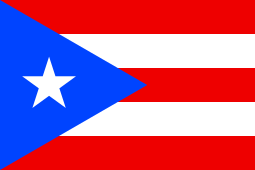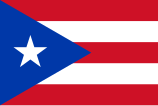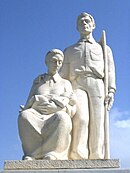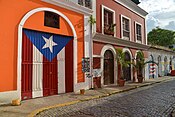
Back Vlag van Puerto Rico Afrikaans علم بورتوريكو Arabic علم بورتوريكو ARZ Puerto-Riko bayrağı Azerbaijani Сцяг Пуэрта-Рыка Byelorussian Zastava Portorika BS Bandera de Puerto Rico Catalan Portorická vlajka Czech Baner Puerto Rico Welsh Puerto Ricos flag Danish

| |
| |
| Use | Civil and state flag, civil and state ensign |
|---|---|
| Proportion | 2:3 |
| Adopted | August 3, 1995 by elected Puerto Rican government after issuing regulation identifying colors but not specifying color shades; medium blue replaced dark blue as de facto shade of triangle[1] |
| |
 | |
| Use | Civil and state flag, civil and state ensign |
| Proportion | 2:3 |
| Adopted | July 24, 1952 by elected Puerto Rican government with the establishment of the commonwealth after issuing law identifying colors but not specifying color shades; dark blue became de facto shade of triangle, replacing presumed original light blue[2][3] |
| |
 | |
| Use | Civil and state flag, civil and state ensign |
| Proportion | 2:3 |
| Adopted | December 22, 1895 by pro-independence members of the Revolutionary Committee of Puerto Rico exiled in New York City; members identified colors as red, white, and blue but did not specify color shades; some historians have presumed members adopted light blue shade based on the light blue flag of the Grito de Lares (Cry of Lares) revolt[4] |
| Design | Five equal horizontal stripes, alternating from red to white, with a blue equilateral triangle based on the hoist side bearing a large, sharp, upright, five-pointed white star in the center; see specifications in Colors and Dimensions |
| Designed by | Disputed between Puerto Ricans Francisco Gonzalo Marín in 1895 and Antonio Vélez Alvarado in 1892; based on Cuban flag by Venezuelan Narciso López and Cuban Miguel Teurbe Tolón in 1849 |
| Part of a series on the |
| Culture of Puerto Rico |
|---|
 |
| Society |
| Topics |
| Symbols |
The flag of Puerto Rico (Spanish: Bandera de Puerto Rico) represents Puerto Rico and its people. It consists of five equal horizontal stripes, alternating from red to white, with a blue equilateral triangle based on the hoist side bearing a large, sharp, upright, five-pointed white star in the center. The white star stands for the island, the three sides of the triangle for the three branches of the government, the blue for the sky and coastal waters, the red for the blood shed by warriors, and the white for liberty, victory, and peace.[5] The flag is popularly known as the Monoestrellada (Monostarred), meaning having one star, a single star, or a lone star.[6][7] It is in the Stars and Stripes flag family.
In September 1868, the Revolutionary Committee of Puerto Rico launched the Grito de Lares (Cry of Lares) revolt against Spanish rule in the island, carrying as their standard the Bandera del Grito de Lares (Grito de Lares Flag), most commonly known as the Bandera de Lares (Lares flag).[8] Marking the establishment of a Puerto Rican national consciousness for the first time, the Lares flag is recognized as the first flag of Puerto Rico.[9]
In December 1895, 27 years after the failed revolt in Lares, exiled members of the committee, settled in New York City and in partnership with exiled Cuban rebels, replaced the Lares flag with the current flag of Puerto Rico as the new revolutionary flag to represent a prospective independent Puerto Rico, basing it on the flag of Cuba, the standard carried by Cubans during their war of independence against Spain. The adoption of the Cuban flag with inverted colors as the new revolutionary flag of Puerto Rico symbolized the strong bonds existing between Cuban and Puerto Rican revolutionaries, and the united independence struggles of Cuba and Puerto Rico as the last two remaining territories of Spain’s once extensive American empire since 1825.[10][11]
Members of the Revolutionary Committee of Puerto Rico identified the colors of their new flag as "red", "white", and "blue" but failed to specify any color shades.[12] Relying on contemporaneous but secondary, oral sources, some historians have presumed that light blue was specifically adopted by the committee members, as their sources claim this was the same shade used on the Lares flag, the first revolutionary flag many of said members had rallied around in 1868.[4] However, like with the flag of 1895, which appears in one of its oldest color depictions in the early 1900s with a medium blue,[13] there is no written primary source account specifying the original color shade of blue used on the Lares flag, the only two surviving original renditions of which feature different shades: one uses light blue[14] and the other dark blue.[15]
In July 1952, after several failed attempts by the insular elected government of Puerto Rico to formalize the revolutionary flag of 1895 as the standard of island, the government adopted it as the official flag of Puerto Rico with the establishment of the Commonwealth of Puerto Rico (Spanish: Estado Libre Asociado de Puerto Rico, lit. 'Free Associated State of Puerto Rico'), identifying its colors by law as "red", "white", and "blue" but not specifying any official color shades.[2][10][16] However, the government began to use a dark blue matching the blue of the American flag as the de facto shade of blue.
In August 1995, the government of Puerto Rico issued a regulation regarding the use of the flag in which it identified the colors to be used as "red", "white", and "blue" but did not specify any official color shades once again.[1] With its promulgation, the government and people began to use a medium blue as the de facto shade of blue, replacing dark blue as the most used color shade. In August 2022, an amendment bill was unsuccessfully introduced in the Puerto Rican Senate which would have established the current medium blue, an azul royal (royal blue), as the official color of the flag.[17]
To this day, the color shades of the flag of Puerto Rico have never been officially determined by law. Therefore, it is common to see the equilateral triangle of the flag with different shades of blue. Occasionally, the shade displayed is used to show preference on the issue of Puerto Rico’s political status, with light blue, presumably used by pro-independence rebels in 1868 and 1895, representing independence from the U.S., dark blue, used by most functionaries since 1952, representing statehood or integration into the U.S. as a state, and medium blue, most commonly used by the government and people since the 1990s, representing the current intermediary status of commonwealth as an unincorporated and organized U.S. territory.
Puerto Rico's flag ranked seventh out of 72 entries in a poll regarding flags of subdivisions of Canada and the United States conducted by the North American Vexillological Association in 2001.[18]
- ^ a b "Reglamento de Puerto Rico 1995". www.lexjuris.com. Retrieved 2023-10-27.
- ^ a b "Ley del 24 de julio de 1952" (PDF). Archived from the original (PDF) on 2012-02-19.
- ^ Cite error: The named reference
reglamento2was invoked but never defined (see the help page). - ^ a b "¿Cuál es el azul correcto de la bandera puertorriqueña?". Primera Hora (in Spanish). December 23, 2014. Retrieved March 7, 2023.
- ^ "Puerto Rico". flagspot.net. Retrieved 12 June 2015.
- ^ ASALE (2023-10-13). "monoestrellada | Diccionario de americanismos". «Diccionario de americanismos» (in Spanish). Retrieved 2023-10-22.
- ^ "La Monoestrellada ya ondea en la plaza de las banderas de los Juegos Panamericanos". Primera Hora (in Spanish). October 18, 2023. Retrieved January 19, 2024.
- ^ "Historical Flags of Puerto Rico". welcome.topuertorico.org. Retrieved 2023-10-25.
- ^ "Puerto Rico - Cinco Siglos de Historia"; por: Francisco Sacrano; editor: McGraw Hill Interamericana, SA, 1993; pág. 533
- ^ a b "Historia de Nuestra Bandera". Ateneo Puertorriqueño. September 16, 2014. Retrieved 24 November 2023.
- ^ "El origen y los colores de nuestra bandera". eladoquintimes.com. Retrieved 2023-11-26.
- ^ "Sobre las banderas de Cuba y Puerto Rico". editorialakelarre.blogspot.com. Retrieved 2023-10-28.
- ^ "Porto Rico United States Possesion, Postcard (1900-1920)". La Biblioteca Digital Puertorriqueña del Sistema de Bibliotecas del Recinto de Río Piedras de la Universidad de Puerto Rico (in Spanish). July 14, 2006. Retrieved November 27, 2023.
- ^ "Exhiben en UPR bandera de Lares con 150 años". Primera Hora (in Spanish). September 16, 2018. Retrieved March 7, 2023.
- ^ "Muestran antigua bandera del Grito de Lares que se exhibe en museo de España". El Nuevo Día (in Spanish). April 22, 2022. Retrieved November 23, 2023.
- ^ Flags of the World; Commonwealth of Puerto Rico, Estado Libre Asociado de Puerto Rico, Flags of the World, Retrieved Feb. 25, 2009
- ^ "Para enmendar la Sección 1 y la Sección 2 de la Ley Núm. 1 de 24 de julio de 1952" (PDF). senado.pr.gov. Retrieved 2024-05-08.
- ^ Kaye, Edward B. (June 10, 2001). "2001 State/Provincial Flag Survey" (PDF). Retrieved February 3, 2024.

